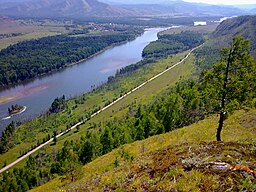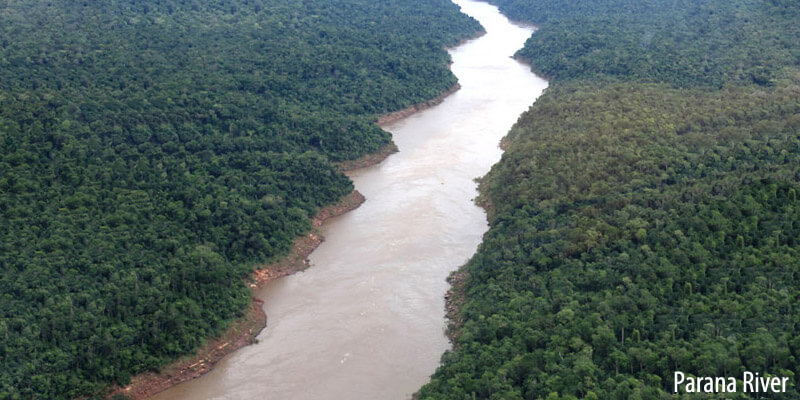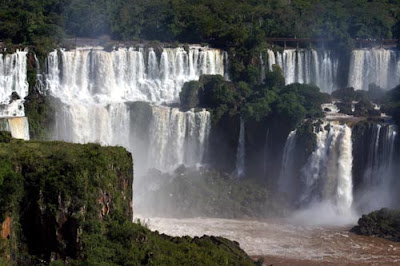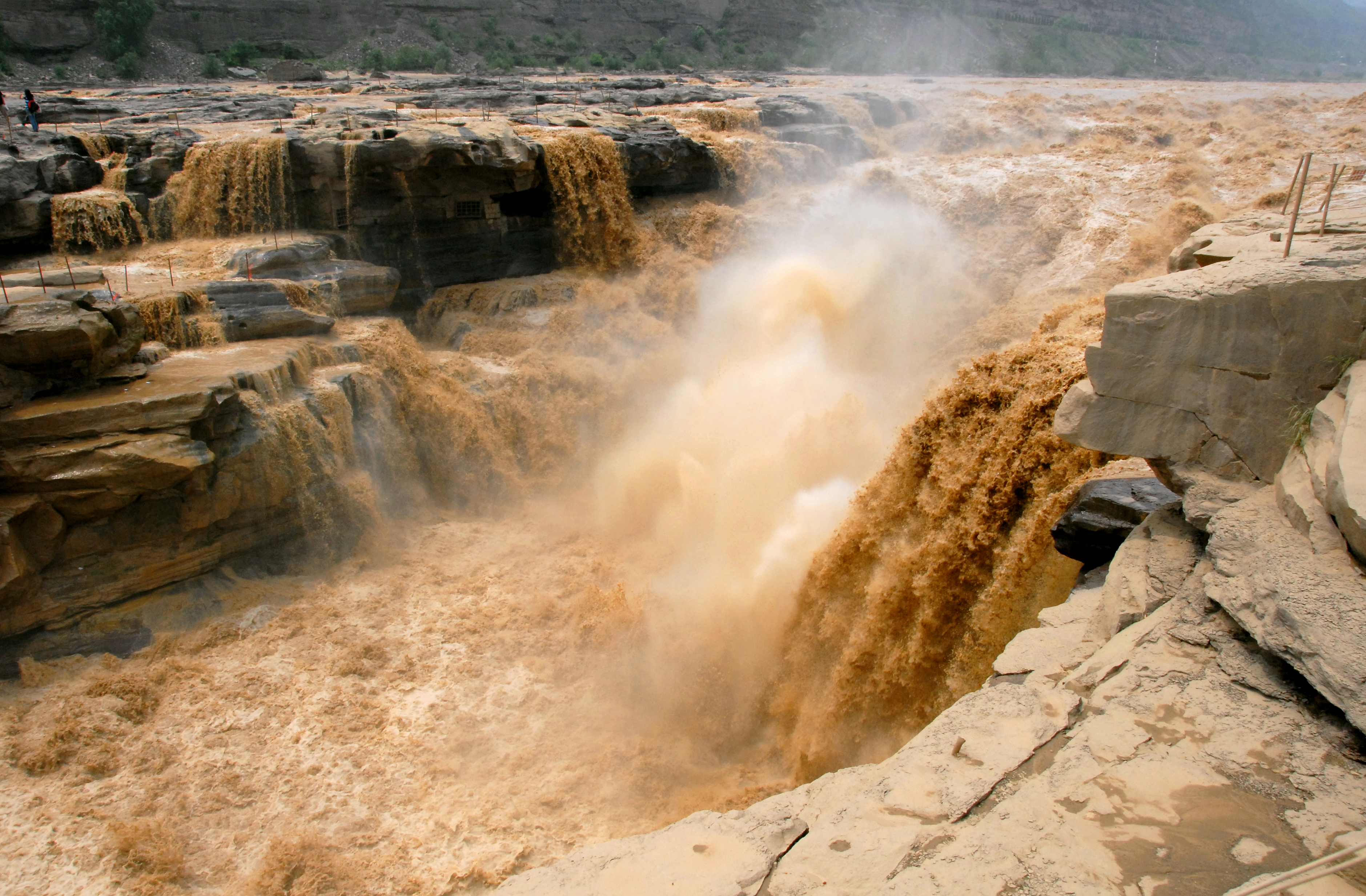Yanisey river also spelled Yenisei or Enisei, Evenk Ioanesi (“Great River”), river of central Russia, one of the longest rivers in Asia. The world’s sixth largest river in terms of discharge, the Yenisey runs from south to north across the great expanse of central Siberia. It traverses a vast region of strikingly varied landscapes where ancient peoples and customs as well as an enormous economic infrastructure are found.
The river begins at the city of Kyzyl in the republic of Tyva (Tuva), Russia, at the confluence of its headstreams—the Great (Bolshoy) Yenisey, or By-Khem, which rises on the Eastern Sayan Mountains of Tyva, and the Little (Maly) Yenisey, or Ka-Khem, which rises in the Darhadïn Bowl of Mongolia. From the confluence the Yenisey River runs for 2,167 miles (3,487 km), mainly along the border between eastern and western Siberia, before emptying into the icy Kara Sea. If the Great Yenisey is considered the source, then the river is 2,540 miles (4,090 km) long. The headwaters of the Selenga (Selenge) River, which rise in western Mongolia and flow through Lake Baikal (the world’s deepest freshwater lake) into the Angara tributary of the Yenisey, may, however, be considered the river’s ultimate source. With the inclusion of the Selenga, the Yenisey is 3,442 miles (5,539 km) long and drains a basin that, at 996,000 square miles (2,580,000 square km), is the seventh largest in the world. The system within Siberia’s boundaries comprises some 20,000 tributary or subtributary streams, with an aggregate length of approximately 550,000 miles (885,000 km). All of the major tributaries of the Yenisey flow from the Central Siberian Plateau to its east, a region constituting 80 percent of the basin area.

Extending for some 2,200 miles (3,500 km) from north to south and for 1,100 miles (1,700 km) from east to west, the Yenisey basin exhibits a considerable diversity of features. Lowlands constitute only 6 to 7 percent of the total area: a narrow strip on the edge of the West Siberian Plain and part of the North Siberian Lowland. In the south the Western and Eastern Sayan, the Tyva, the Baikal, the Hangayn, and the Hentiyn mountains constitute a larger proportion of the basin’s area, with elevations mostly between 2,300 and 7,200 feet (700 and 2,200 metres), steep valleys, and vast bowls between ranges. In southern Tyva and in the Sayans, there are some magnificent higher peaks, culminating in Mount Munku-Sardyk (Mönh Sarĭdag), which reaches an elevation of 11,453 feet (3,491 metres). Most of the basin stretches over the western sector of the Central Siberian Plateau—with elevations between 1,640 and 2,300 feet (500 and 700 metres). The basin is bordered in the northeast by the Putorana Mountains, which rise to 5,580 feet (1,701 metres); in the west by the Yenisey Ridge, with an elevation of 3,622 feet (1,104 metres); and in the southeast by the Angara Ridge, with an elevation of 3,353 feet (1,022 metres).
The Yenisey River proper is divisible into three principal sections: the 295 miles (475 km) from Kyzyl to Oznachennoye on the southern edge of the Minusinsk Basin, the 544 miles (875 km) from Oznachennoye to the Angara confluence, and the 1,328 miles (2,137 km) from the Angara confluence to the sea.
The Yenisey River near its confluence with the Angara River, south-central Siberia.
Masahiro Iijima/Ardea London
Flowing west through the Tyva Basin for the first 115 miles (185 km) from Kyzyl, the Yenisey varies in width from 100 to 700 yards (90 to 640 metres) and often splits into braided channels around gravelly shoals. At the western end of the basin, the river flows into the Sayano-Shushen Reservoir, which receives the Khemchik River. The Yenisey flows north through the reservoir, occupying a now-submerged canyon that cuts across the Western Sayan.
TEST YOUR KNOWLEDGE
The Forbidden City, Beijing. All About Asia
After leaving the reservoir and flowing out of the mountains at Oznachennoye, the Yenisey broadens its valley in the Minusinsk Basin: just below the Abakan confluence, the valley is more than 3 miles (5 km) wide; the bed, about 500 yards (460 metres) from bank to bank, is studded with islands; the flow velocity is reduced to about 6 feet (2 metres) per second; and the long and narrow Krasnoyarsk Reservoir, contained on the east by northwestern spurs of the Eastern Sayan, begins. The reservoir stretches some 240 miles (390 km) downstream to Divnogorsk. Downstream from the reservoir and slightly above Krasnoyarsk, the river valley broadens, as does the bed. Rapids are common there, the best-known being those at Kazachinskiy.
Below the Angara confluence, the right bank of the Yenisey remains an upland and is often precipitous, but the left bank becomes a floodplain. The bed, only 870 yards (800 metres) wide above the confluence, broadens to 3,000 yards (2,700 metres) wide below it; depth increases to between 32 and 56 feet (10 and 17 metres), and the flow velocity drops by 50 percent or more. Farther downstream, however, just above the confluence of the Stony (Podkamennaya) Tunguska River, the Yenisey cuts through spurs of the Yenisey Ridge; rapids occur at Osinovo, and below them the river plunges down a scenic gorge in which its bed narrows to a width of 800 yards (730 metres). Below the confluence with the Lower (Nizhnyaya) Tunguska River, the valley widens to 23 miles (37 km), expanding to about 93 miles (150 km) wide around Dudinka and Ust-Port; the bed’s width increases to 2,700 yards (2,500 metres) and then to 5,500 yards (5,000 metres); depths over the Yenisey’s lower course range from 16 feet (5 metres) to more than 80 feet (24 metres).
The estuary of the Yenisey begins as far upstream as the confluence of the Kureyka (the next considerable tributary north of the Lower Tunguska). Below Dudinka the bed is in places divided by islands, some of them 10 or 12 miles (16 or 19 km) long, and a true delta begins north of Ust-Port, where the numerous Brekhov Islands divide the river into channels, with the westernmost bank about 47 miles (76 km) from the easternmost. The several channels empty into a long, wide bay leading into the Yenisey Gulf of the Kara Sea.
CONNECT WITH BRITANNICA
The largest tributaries of the upper and middle Yenisey are the Khemchik and Abakan rivers from the left and the Tuba River from the right. Fed chiefly by rainwater and melting snow, they begin their spring high water in late April and are swollen by summer rain floods. The Angara, on the other hand, is highly regulated by its source—the huge Lake Baikal—and rarely experiences low water. With a length of 1,105 miles (1,778 km), its own basin of more than 407,700 square miles (1,056,000 square km)—twice the size of the Yenisey’s above their confluence—and a greater volume at its mouth than that of the Yenisey above the confluence, the Angara might better be recognized as the upper course of the main river than as a tributary. The Stony Tunguska and the Lower Tunguska rivers, with an aggregate volume of about 176,000 cubic feet (4,980 cubic metres) per second, also make a substantial contribution to the Yenisey’s runoff.
Hydrology
About half of the Yenisey’s water comes from snow, a little more than one-third from rainwater, and the remainder from groundwater. For the greater part of the system, the eastern Siberian hydrologic regime prevails: violent spring floods are followed first by a rapid fall of levels, then by a slower fall, with summer and autumn rain floods punctuating the sequence; in winter the runoff is reduced sharply, but levels remain high as ice jams are formed. In terms of runoff, the Yenisey is the largest river in Russia, with about 150 cubic miles (620 cubic kilometres) annually. It carries about 10.5 million tons of alluvium into the Kara Sea every year, in addition to nearly 30 million tons of dissolved mineral substances. In midsummer the water temperature varies from 57 °F (14 °C) to 66 °F (19 °C), but freezing begins on the lower Yenisey early in October and affects the entire river by mid-November; ice jams and underwater ice are characteristic. Thawing occurs toward the end of April on the upper reaches, in May on the middle, and from May to mid-June on the lower. The water of the middle Yenisey is highly turbid in spring and summer and contrasts sharply with the limpid water of the Angara; and in summer the two streams flow in the same bed without mingling for 9 miles (14 km) or so from their confluence.
The Yenisey basin has a subarctic climate in its northern part and markedly continental conditions in the middle and southern portions. The cold season prevails from late September to mid-June in the north and from mid-October to late April in the south. Even summer is cool in the northern basin, with average temperatures of 46 to 54 °F (8 to 12 °C) in July, when frosts may still occur; but summer is warm in the south, with July averages between 64 and 68 °F (18 and 20 °C). The average temperature for January in the north ranges from −25 to −18 °F (−32 to −28 °C) and in the south warms to about −4 °F (−20 °C). Annual precipitation averages 16 to 20 inches (400 to 500 mm) in the north; 20 to more than 30 inches (500 to more than 750 mm) in the central portion, and up to 47 inches (1,190 mm) in the mountains south of the basin. The closed depressions in the upper basin receive from less than 8 to about 12 inches (less than 200 to about 300 mm) annually. Most of the rain (80 to 90 percent) falls in the warmer months, chiefly in late summer and early autumn. Snow cover is light in most of the basin, averaging 16 inches (40 cm) in the south, 24 inches (60 cm) in the north, and 35 inches (90 cm) on the Yenisey Ridge. Because the light snow offers little insulation, the soil and subsoil are frozen to a considerable depth for long periods over most of the basin. Permafrost is prevalent north of the Lower Tunguska.
Most of the basin is covered with taiga (marshy, primarily coniferous forest), with Siberian spruce, fir, and cedar predominating in the south and larch farther north. In Mongolia, Transbaikalia, and Tyva there are also steppe grasslands, bordered in the extreme south of the Selenga River basin by semidesert. In the far north of the basin, taiga is superseded by tundra (marshy plain covered with moss and other low, cold-tolerant plants).
The Yenisey and its tributaries are rich in fish: the mountain streams of the headwaters support grayling, trout, lenok, roach, and dace; the middle course has sterlet, trout, goldilocks, several species of whitefish (genus Coregonus), and grayling; the lower course has Siberian lamprey, Siberian sturgeon, sterlet, Alpine char, trout, gold and silver carp, pike, and many others. The estuary has fewer species of fish but is rich in the economically valuable sturgeon. The lower reaches of the Yenisey are also much favoured in summer by migrant waterfowl from the south; the small lakes and islands support ducks, geese, and swans; and the muskrat has adapted to the channels of the delta.
PEOPLE
The peoples of the Yenisey valley are diverse. Around the western headwaters (Great and Little Yenisey), Tyvans (Tuvans) predominate in the rural areas, but they are joined by significant numbers of Russians in Kyzyl, the capital of Tyva. To the north of Tyva the Krasnoyarsk kray (territory) of Russia extends down the entire valley northward to the Kara Sea; its population comprises Russians, Ukrainians, Tatars, and numerous other indigenous peoples. The Khakass people occupy Khakassia southwest of Krasnoyarsk. The vast Evenk autonomous okrug (district), extending from south of the Stony Tunguska to north of the Kureyka, is inhabited both by the Evenk people and by Russians from the west and Sakha (Yakut) from the east. In the far north, the Taymyr autonomous okrug has a majority of Russians and some Evenk but also the Sakha, Dolgan, Nenets, and Nganasan peoples.
ECONOMY
Hunting, fishing, the breeding of reindeer, and fur farming are the traditional occupations of the more northerly peoples, and there is some mining of coal and nonferrous ores (copper, nickel) around Norilsk. Considerable industrial development has occurred in the south, with major centres at Krasnoyarsk, Irkutsk, and Bratsk. The hydroelectric potential of the Yenisey and its major tributary, the Angara—the greatest of any river system in Russia—is also among the most heavily exploited. Since the 1950s, power stations have been built on the Angara at Irkutsk, Bratsk, and Ust-Ilimsk and on the upper and middle Yenisey at Krasnoyarsk and Sayan, with a combined total generating capacity exceeding 25 million kilowatts. Another station on the Angara, at Boguchany, was completed in the late 1980s.
The Yenisey is regularly navigated between Oznachennoye and the sea. A great elevator capable of lifting ships along an inclined railroad between the upper and lower waters of the Krasnoyarsk Hydroelectric Station has been constructed to permit through traffic. The chief ports are Krasnoyarsk, Strelka (at the Angara confluence), Yeniseysk, Igarka, Dudinka, and Ust-Port; seagoing vessels sail up to Igarka. Lumber is the main cargo. Some of the cargo goes upstream to Krasnoyarsk, but the downstream traffic carries bread, coal, petroleum products, and machinery, as well as lumber.
STUDY AND EXPLORATION
Russians first settled on the Yenisey in 1607, when a winter station was established on the Turukhan River (a left-bank tributary joining the Yenisey just below the Lower Tunguska confluence). Novgorod merchants, however, may have been trading with peoples of the valley as early as the 11th century. In 1619 a fort was built at Yeniseysk. Nine years later Krasny Yar (now Krasnoyarsk) was founded, and Irkutsk was settled in 1652. From these places roads went eastward into the Buryat country and southward into the fertile Minusinsk Basin. The Russian hold on the line of the Yenisey was definitively secured early in the 18th century. Exploration of the rivers was then initiated, with a detachment of the Great Northern Expedition (1733–42) operating on the Yenisey. Later, the lower Yenisey was explored by an expedition of 1894–96; and from 1907 to 1912 a party made a more thorough investigation of the entire river. Studies for development plans or for scientific purposes continued throughout the 20th century.


_oji5-4m.jpg)











